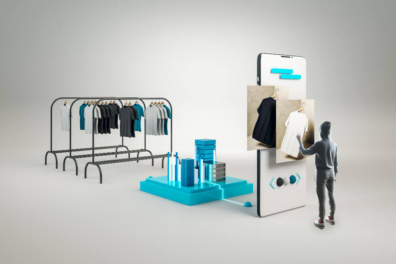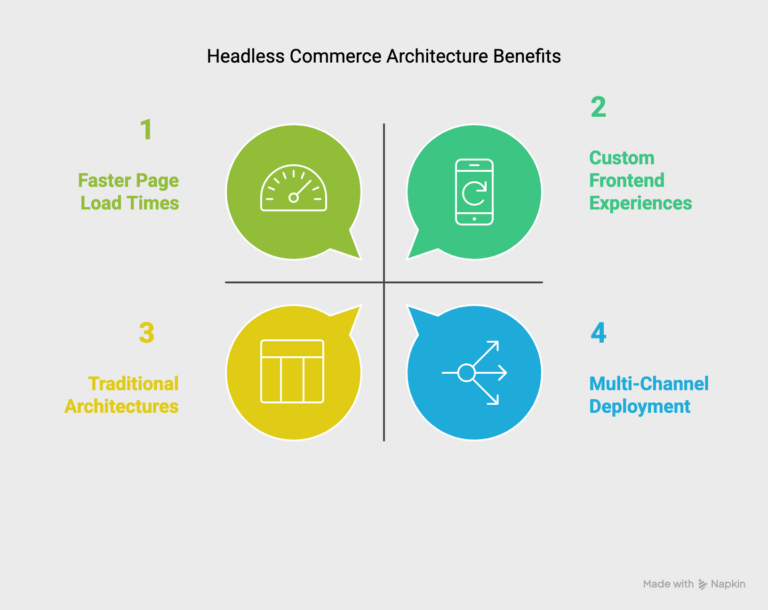Greetings! I'm Aneesh Sreedharan, CEO of 2Hats Logic Solutions. At 2Hats Logic Solutions, we are dedicated to providing technical expertise and resolving your concerns in the world of technology. Our blog page serves as a resource where we share insights and experiences, offering valuable perspectives on your queries.

QUICK SUMMARY
Traditional Magento offers an all-in-one solution with a tightly coupled frontend and backend, ideal for businesses seeking simplicity and lower initial costs. Headless commerce separates these layers through APIs, providing superior speed (up to 79% faster), greater flexibility for custom experiences, and better omnichannel capabilities, but requires more specialized skills and higher upfront investment.
Choose traditional Magento for simplicity and faster deployment; consider headless for unique customer experiences, performance optimization, and multi-channel selling. Your decision should align with your specific business goals, technical capabilities, and long-term growth strategy.
Ever found yourself scratching your head over which e-commerce approach would work best for your growing business? You’re not alone.
The debate between headless commerce and traditional Magento has left many merchants wondering which path leads to better customer experiences and stronger sales.
At 2HatsLogic, we’ve guided numerous businesses through this crucial decision. Let’s break down these two distinct approaches to help you determine which fits your unique business needs.
Understanding Traditional Magento
Traditional Magento represents the classic approach to e-commerce platforms, a comprehensive, monolithic system. The frontend presentation layer and backend functionality are tightly coupled together.
When a customer visits your Magento store, here’s what happens:
- The browser sends a request to your Magento server
- Magento processes the request through its PHP-based architecture
- The server generates HTML and sends it back to the browser
- The customer sees your storefront with all its features and content
This integrated approach has been the backbone of online retail for years, offering:
Strengths of Traditional Magento:
- Complete out-of-the-box functionality
- Unified admin interface for all store operations
- An extensive ecosystem of extensions and themes
- Lower initial development complexity
The Headless Commerce
Headless commerce takes a fundamentally different approach by separating (or decoupling) the frontend presentation layer from the backend e-commerce functionality.
In a headless setup:
- The frontend is built using modern frameworks like React, Vue, or Angular
- The backend handles core e-commerce functions like inventory, orders, and payments
- Communication happens through APIs (Application Programming Interfaces)
- Content can be delivered to any device or touchpoint, not just websites
This separation creates remarkable flexibility that traditional architectures simply can’t match.
Strengths of Headless Commerce:

- Freedom to create custom frontend experiences
- Faster page load times and performance
- Ability to deploy to multiple channels (mobile apps, kiosks, IoT devices)
- Easier integration with best-of-breed services
PRO TIP: When implementing a headless commerce solution, start by mapping your customer journey across all touchpoints. This exercise will help identify which channels need custom experiences that a traditional architecture might struggle to support.
The Key Differences: Headless Commerce vs Traditional Magento
Let’s compare these approaches across the factors that matter most to e-commerce businesses:
1. Development Approach & Flexibility
Traditional Magento: Traditional Magento follows a template-based approach where your store’s appearance and functionality are closely tied together. Customizations often require working within Magento’s existing structure and conventions.
Headless Commerce: Headless gives your development team freedom to create custom user interfaces using any frontend technology. This means you can craft unique experiences tailored to your brand and customer needs without being constrained by platform limitations.
Want to explore if your business needs greater frontend flexibility?
2. Performance & User Experience
Traditional Magento: While Magento has improved performance over the years, its monolithic nature means every page request must process through the entire Magento stack. This can lead to slower load times, especially on mobile devices or with complex catalogs.
Headless Commerce: Headless architectures can deliver dramatically faster experiences. Modern frontend frameworks like Next.js or Gatsby can serve static pages that load instantly, while API calls fetch only the dynamic data needed. This approach can reduce page load times from seconds to milliseconds.
In a recent project, our team helped a fashion retailer move from traditional Magento to a headless approach, reducing their average page load time from 4.2 seconds to just 1 second, a 79% improvement that directly contributed to a 34% increase in conversion rates.
| Metric | Traditional Magento | Headless Implementation | Improvement |
|---|---|---|---|
| Page Load Time | 4.2 seconds | 0.9 seconds | 79% faster |
| Mobile Conversion | 1.8% | 2.4% | 33% increase |
| Server Response | 820ms | 120ms | 85% faster |
Curious about how much faster your store could be?
3. Omnichannel Capabilities
Traditional Magento: This was designed primarily for web storefronts. While extensions exist for other channels, each new touchpoint often requires significant custom development and maintenance.
Headless Commerce: Headless architecture excels at omnichannel retail. The same backend can power websites, mobile apps, in-store kiosks, voice shopping, and even IoT devices, with experiences optimized for each channel.
PRO TIP: When planning your omnichannel strategy, focus first on the channels where your customers shop. It’s better to deliver exceptional experiences on fewer channels than mediocre experiences everywhere.
4. Content Management & Marketing
Traditional Magento: Content management in traditional Magento has limitations. While you can create basic CMS pages and blocks, complex content layouts often require developer assistance.
Headless Commerce: Headless approaches allow integration with specialized content management systems like Contentful or Sanity. This gives marketing teams powerful tools to create and publish content without developer dependency.
5. Development & Maintenance Costs
Traditional Magento
- Lower initial development costs
- Higher long-term maintenance expenses
- Limited ability to reuse components across channels
Headless Commerce
- Higher upfront investment
- Lower ongoing maintenance costs per channel
- More efficient scaling as the business grows
PRO TIP: When budgeting for e-commerce platforms, consider the total cost of ownership over a 3-5 year period. What seems cheaper initially might become more expensive when accounting for ongoing development, maintenance, and missed opportunities.
Who Should Choose Traditional Magento?
Traditional Magento remains an excellent choice for businesses that:
- Need a complete solution with minimal technical complexity
- Have simpler requirements focused mainly on web commerce
- Operate with limited development resources or budget
- Require faster time-to-market for basic eCommerce functionality
A regional specialty food retailer we worked with chose to stay with traditional Magento because their business focused entirely on web sales, and they lacked the internal technical team to support a more complex architecture. For them, the simplicity of managing everything in one place outweighed the benefits of headless.
Who Should Consider Headless Commerce?
Headless commerce is particularly valuable for businesses that:
- Prioritize unique customer experiences as a competitive advantage
- Sell across multiple channels beyond just websites
- Need exceptional performance for conversion optimization
- Have complex content requirements beyond product listings
- Plan to scale significantly shortly
Making Your Decision
When helping our clients decide between headless commerce and traditional Magento, we use this four-step framework:
- Assess your business goals and competitive landscape
- Are unique experiences a key differentiator in your market?
- How important is omnichannel to your growth strategy?
- Evaluate your technical capabilities and resources
- Do you have access to development talent with modern stack experience?
- Can your team support a more complex architecture?
- Consider your timeline and budget constraints
- Can you invest in longer-term benefits vs. immediate launch?
- How do you balance initial costs against long-term TCO?
- Analyze your specific requirements
- Which specific limitations of traditional architecture are holding you back?
- Would headless solve your most pressing challenges?
PRO TIP: Don’t follow trends for their own sake. While headless commerce offers exciting benefits, it’s not right for every business. Be honest about your specific needs and capabilities when making this decision.
Conclusion
The choice between headless commerce and traditional Magento isn’t about which is universally “better”; it’s about which approach best serves your business needs, technical capabilities, and customer expectations.
Traditional Magento continues to excel for businesses seeking an integrated, straightforward e-commerce solution with comprehensive out-of-box functionality.
Headless commerce shines for companies prioritizing cutting-edge experiences, omnichannel sales, and the flexibility to evolve rapidly as technology and consumer behavior change.
At 2HatsLogic, we’ve helped dozens of merchants navigate this critical decision and implement the right solution for their unique circumstances. Whether you choose the proven reliability of traditional Magento or the innovative flexibility of headless commerce, having experienced partners guiding your implementation can make all the difference.
Ready to explore which approach is right for your business? Contact our team for a free consultation and discover how we can help transform your e-commerce strategy.
FAQ
Does going headless mean abandoning Magento completely?
Not at all! Many businesses implement "headless Magento" where they keep Magento as their backend commerce engine but replace the frontend with a custom implementation. This approach leverages Magento's powerful commerce capabilities while gaining the benefits of a modern frontend.
How much more expensive is headless commerce compared to traditional Magento?
Initial development costs for headless implementations typically run 30-50% higher than traditional Magento setups. However, these costs are often recovered through improved conversion rates, lower ongoing maintenance expenses, and reduced need for replatforming as your business evolves.
Will my team need new skills to manage a headless commerce platform?
Yes, headless architectures typically require different skill sets. Frontend developers will need expertise in modern JavaScript frameworks, while backend teams need API development experience. However, marketing teams often find headless systems more user-friendly once implemented, as they gain more control over content and experiences.
Is it possible to transition gradually from traditional to headless?
Absolutely! Many of our clients implement headless commerce incrementally, starting with specific sections of their store (like content pages or the blog) while keeping core shopping functionality on traditional architecture. This phased approach reduces risk and spreads investment over time.

Related Articles






